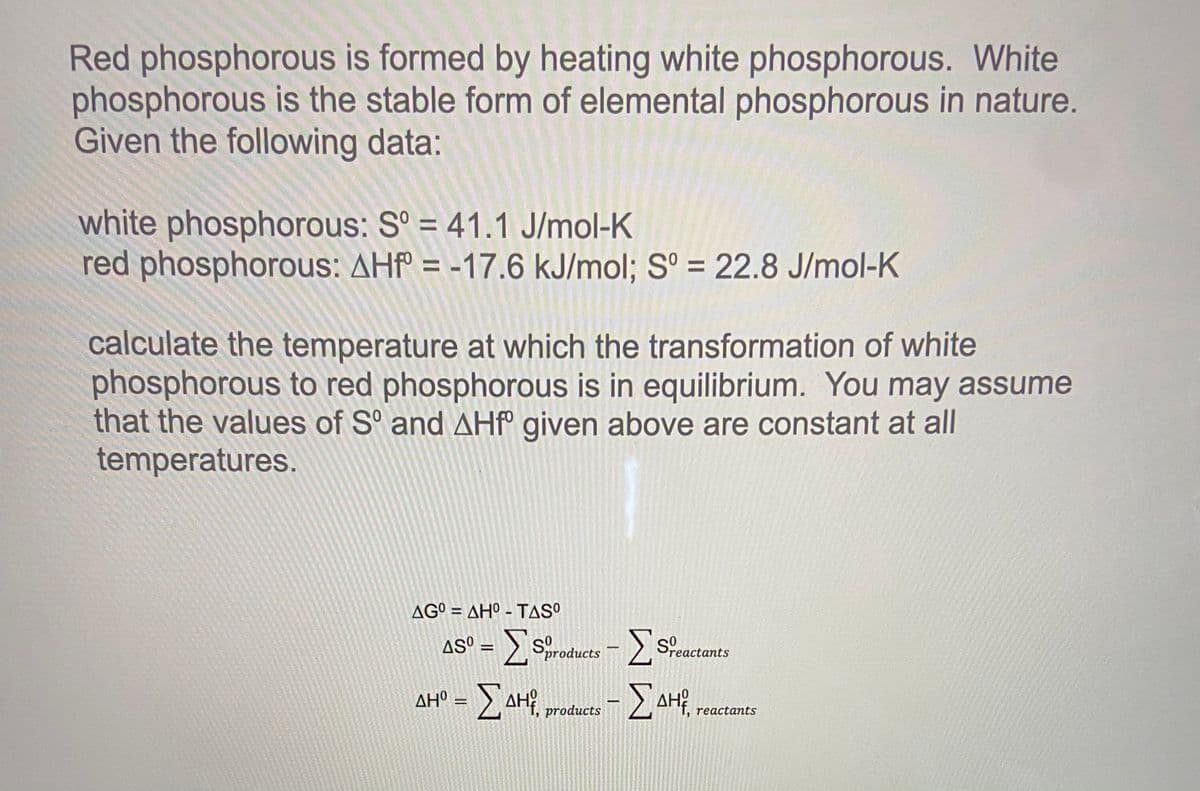Red phosphorous is formed by heating white phosphorous. White phosphorous is the stable form of elemental phosphorous in nature. Given the following data: white phosphorous: S° = 41.1 J/mol-K red phosphorous: AHF° = -17.6 kJ/mol; S° = 22.8 J/mol-K calculate the temperature at which the transformation of white phosphorous to red phosphorous is in equilibrium. You may assume that the values of S° and AHf given above are constant at all temperatures.
Red phosphorous is formed by heating white phosphorous. White phosphorous is the stable form of elemental phosphorous in nature. Given the following data: white phosphorous: S° = 41.1 J/mol-K red phosphorous: AHF° = -17.6 kJ/mol; S° = 22.8 J/mol-K calculate the temperature at which the transformation of white phosphorous to red phosphorous is in equilibrium. You may assume that the values of S° and AHf given above are constant at all temperatures.
Chemistry for Engineering Students
4th Edition
ISBN:9781337398909
Author:Lawrence S. Brown, Tom Holme
Publisher:Lawrence S. Brown, Tom Holme
Chapter9: Energy And Chemistry
Section: Chapter Questions
Problem 9.38PAE: 9.38 The energy densities of various types of coal are listed below: Anthracite 35 kJ/g...
Related questions
Question

Transcribed Image Text:Red phosphorous is formed by heating white phosphorous. White
phosphorous is the stable form of elemental phosphorous in nature.
Given the following data:
white phosphorous: S° = 41.1 J/mol-K
red phosphorous: AHf = -17.6 kJ/mol; S° = 22.8 J/mol-K
%3D
%3D
calculate the temperature at which the transformation of white
phosphorous to red phosphorous is in equilibrium. You may assume
that the values of S° and AHP° given above are constant at all
temperatures.
AG° = AHº - TASO
%3D
AS° = > sroducts - ) Scactants
reactants
AH° = >,AH¥, products
Σ
Δ
reactants
Expert Solution
This question has been solved!
Explore an expertly crafted, step-by-step solution for a thorough understanding of key concepts.
This is a popular solution!
Trending now
This is a popular solution!
Step by step
Solved in 3 steps

Knowledge Booster
Learn more about
Need a deep-dive on the concept behind this application? Look no further. Learn more about this topic, chemistry and related others by exploring similar questions and additional content below.Recommended textbooks for you

Chemistry for Engineering Students
Chemistry
ISBN:
9781337398909
Author:
Lawrence S. Brown, Tom Holme
Publisher:
Cengage Learning

Chemistry: The Molecular Science
Chemistry
ISBN:
9781285199047
Author:
John W. Moore, Conrad L. Stanitski
Publisher:
Cengage Learning

Chemistry: Principles and Reactions
Chemistry
ISBN:
9781305079373
Author:
William L. Masterton, Cecile N. Hurley
Publisher:
Cengage Learning

Chemistry for Engineering Students
Chemistry
ISBN:
9781337398909
Author:
Lawrence S. Brown, Tom Holme
Publisher:
Cengage Learning

Chemistry: The Molecular Science
Chemistry
ISBN:
9781285199047
Author:
John W. Moore, Conrad L. Stanitski
Publisher:
Cengage Learning

Chemistry: Principles and Reactions
Chemistry
ISBN:
9781305079373
Author:
William L. Masterton, Cecile N. Hurley
Publisher:
Cengage Learning

Chemistry: An Atoms First Approach
Chemistry
ISBN:
9781305079243
Author:
Steven S. Zumdahl, Susan A. Zumdahl
Publisher:
Cengage Learning

Chemistry by OpenStax (2015-05-04)
Chemistry
ISBN:
9781938168390
Author:
Klaus Theopold, Richard H Langley, Paul Flowers, William R. Robinson, Mark Blaser
Publisher:
OpenStax

General Chemistry - Standalone book (MindTap Cour…
Chemistry
ISBN:
9781305580343
Author:
Steven D. Gammon, Ebbing, Darrell Ebbing, Steven D., Darrell; Gammon, Darrell Ebbing; Steven D. Gammon, Darrell D.; Gammon, Ebbing; Steven D. Gammon; Darrell
Publisher:
Cengage Learning